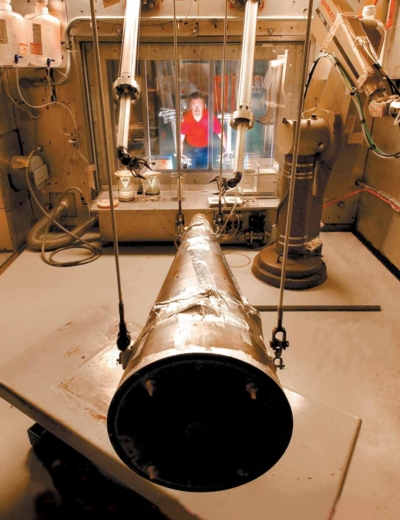
“It is not true,” British Defence Secretary Des Browne insisted during an interview with BBC radio, that a new fuze planned for British nuclear warheads and reported by the Guardian will increase their military capability. The plan to replace the fuze “was reported to the [Parliament’s] Select Committee in 2005 and is not an upgrading of the system; it is merely making sure that the system works to its maximum efficiency,” Mr. Browne says.
The minister is either being ignorant or economical with the truth. According to numerous statements made by US officials over the past decade, the very purpose of replacing the fuze is – in stark contrast to Mr. Browne’s assurance – to give the weapon improved military capabilities it did not have before.
The matter, which is controversial now because Britain is debating whether to build a new generation of nuclear-armed submarines, concerns the Mk4 reentry vehicle on Trident D5 missiles deployed on British (and US) ballistic missile submarines. The cone-shaped Mk4 contains the nuclear explosive package itself and is designed to protect it from the fierce heat created during reentry of the Earth’s atmosphere toward the target. A small fuze at the tip of the Mk4 measures the altitude and detonates the explosive package at the right “height of burst” to create the maximum pressure to ensure destruction of the target. The new fuze will increase the “maximum efficiency” significantly and give the British Trident submarines hard target kill capability for the first time.
US Statements About Enhanced Capability
Unlike the British government, US officials and agencies have been very clear that the new fuze is not merely a replacement but a significant upgrade that will give the Mk4 significant military capabilities. The Department of Energy’s Stockpile Stewardship and Management Plan from 1997 stated that the whole purpose of developing a new fuze in the first place was to “enable [the] W76 to take advantage of [the] higher accuracy of the D5 missile.”
At about the same time, the head of the US Navy’s Strategic Systems Command, Rear Admiral George P. Nanos, explained in The Submarine Review that the “capability for the [existing] Mk4…is not very impressive by today’s standards, largely because the Mk4 was never given a fuze that made it capable of placing the burst at the right height to hold other than urban industrial targets at risk.” But “with the accuracy of D5 and Mk4, just by changing the fuse in the Mk4 re-entry body, you get a significant improvement,” Admiral Nanos stated. In fact, “the Mk4, with a modified fuze and Trident II accuracy, can meet the original D5 hard target requirement.”
| Trident Mk4A Reentry Vehicle |
 |
| The US Navy is saying – and the British government is denying – that a new fuze for the Mk4 reentry vehicle will increase the capability against hard targets. |
For US war planners, this improvement was necessary because the main US hard target killer, the MX Peacekeeper ICBMs with high-yield W87 warheads, were being retired as a result of the never-ratified 1992 START II treaty and the 2002 Moscow Treaty (SORT). The last Peacekeeper stood down in 2005. Some of the W87 are now being backfitted unto the Minuteman III ICBMs with a new guidance system to retain ICBM hard target kill capability. The Navy has a dedicated hard target kill W88 warhead on some of its D5 missiles, but with the new fuze on the W76-1/Mk4A the hard target kill capability will increase significantly. The first W76-1/Mk4A is scheduled to be delivered in September 2007.
Implications for British Deterrence
Admiral Nanos’ statement implies that British Trident submarines have never had hard target kill capability “because the Mk4 was never given a fuze that made it capable of placing the burst at the right height to hold other than urban industrial targets at risk.” With the new fuze, however, the British Trident submarines “can meet the original D5 hard target requirement,” and hold at risk the full range of targets.
So why does the British upgrade come now? After all, British nuclear submarines have cruised the oceans for decades with less capable fuzes and still ensured, so it has been said, Britain’s survival and made “significant contributions” to NATO’s deterrence.
There are several possibilities. British nuclear planners may have successfully argued that they need more accurate nuclear weapons to better deter potential adversaries. That is the dynamic the created in the Trident system during the Cold War. Since then, Britain has moved from a Soviet-focused deterrent to a “Goldilocks doctrine” today aimed against three incremental sizes of adversaries: Russia, “rogue” states, and terrorists.
Another possibility is that it may be a result of Britain not having an independent deterrent. Rather than designing and building its nuclear missiles itself, British leases them from the US missile inventory. The warhead installed on the “British” missiles is believed to be a modified – but very similar – version of the American W76. But the reentry vehicle that contains the explosive package appears to be the same: the Mk4. And since the US is upgrading its Mk4 to the Mk4A with the new fuze, Britain may simply have gotten the new capability with its existing lease.
Whatever the reason, the British government’s denial is clearly flawed. If the government believes so strongly that a nuclear deterrent is still necessary, why be so timid about its new capability? After all, what is the new capability good for if the potential adversaries can’t be told about it? And if the British government believes in the nuclear deterrent, then it has to play the deterrence role and be honest about it, and not – as it does now – pretend to be a nuclear disarmer while secretly enhancing its nuclear weapons capabilities.
The FY2026 National Defense Authorization Act (NDAA) paints a picture of a Congress that is working to both protect and accelerate nuclear modernization programs while simultaneously lacking trust in the Pentagon and the Department of Energy to execute them.
While advanced Chinese language proficiency and cultural familiarity remain irreplaceable skills, they are neither necessary nor sufficient for successful open-source analysis on China’s nuclear forces.
Satellite imagery has long served as a tool for observing on-the-ground activity worldwide, and offers especially valuable insights into the operation, development, and physical features related to nuclear technology.
This report outlines a framework relying on “Cooperative Technical Means” for effective arms control verification based on remote sensing, avoiding on-site inspections but maintaining a level of transparency that allows for immediate detection of changes in nuclear posture or a significant build-up above agreed limits.